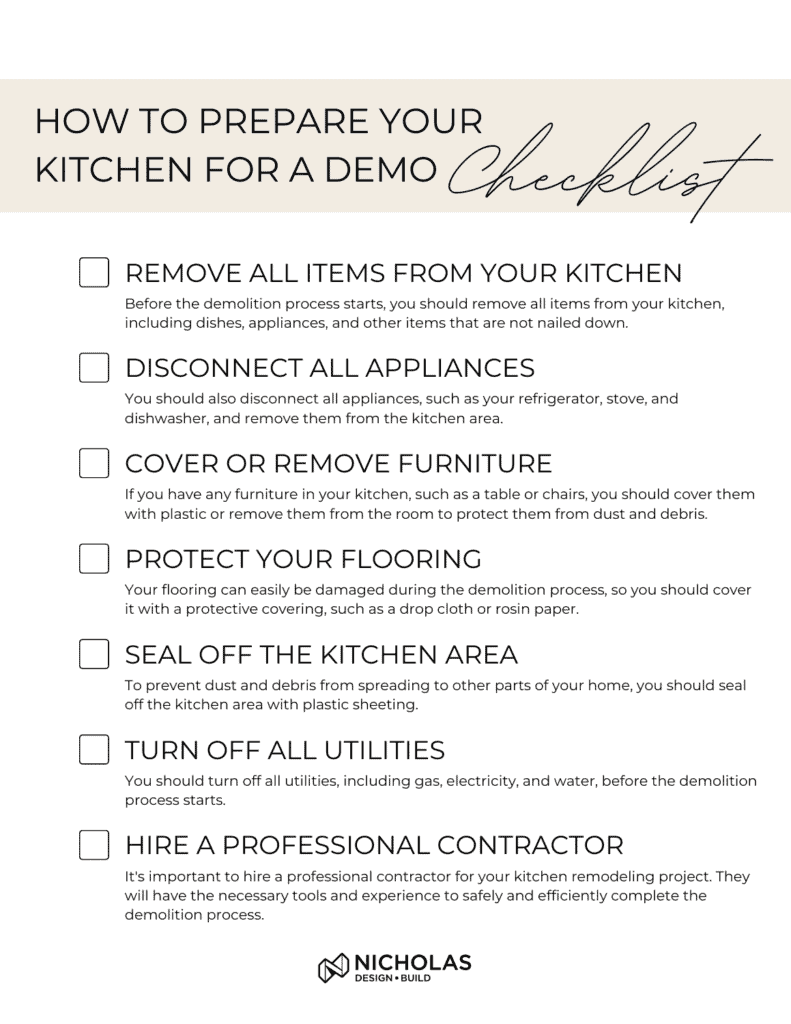A kitchen remodel can be a big project. What is the best way to prepare for a kitchen remodel? The best way to prepare is to plan carefully, set a budget, find the right professionals, and make arrangements for cooking during the renovation. A kitchen remodel can dramatically improve your home’s value and your enjoyment of the space. But it can also be stressful. This guide provides a detailed kitchen renovation checklist to help you through each step, ensuring a smoother, less stressful experience.

Image Source: nicholasdesignbuild.com
The Preliminary Steps: Laying the Groundwork for Success
Before swinging a hammer, careful planning is crucial. Rushing into a remodel without a clear vision and solid strategy can lead to costly mistakes and unnecessary headaches. These initial steps set the stage for a successful and satisfying kitchen transformation. This involves thorough kitchen remodel planning and gathering inspiring kitchen design ideas.
Dream Big, Plan Smart: Defining Your Vision
Start by envisioning your ideal kitchen. Consider your current needs, lifestyle, and long-term goals.
-
Needs vs. Wants: What are the must-have features, and what are the nice-to-haves? Do you need more storage, updated appliances, or a better layout for cooking?
-
Lifestyle Considerations: Do you entertain frequently? Do you have young children? How much time do you spend cooking? Your answers will influence your design choices.
-
Inspiration Gathering: Browse magazines, websites (like Houzz, Pinterest), and home improvement shows for kitchen design ideas. Save images of kitchens you love, noting the specific elements that appeal to you.
-
Layout Considerations: Consider the kitchen work triangle (sink, refrigerator, stove) and how well your current layout functions. Think about traffic flow and accessibility.
Deciphering the Details: Creating a Design Blueprint
Once you have a general idea of your dream kitchen, it’s time to get more specific. This is where the design starts to take shape.
-
Measure Your Space: Accurately measure your kitchen, including wall lengths, window and door openings, and ceiling height. Draw a rough sketch of the existing layout.
-
Draft a Preliminary Layout: Using your measurements and inspiration, create a basic floor plan. Experiment with different layouts to see what works best for your space and needs.
-
Appliance Selection Guide: Research appliance brands and models. Consider energy efficiency, features, and aesthetics. Note the dimensions of the appliances you’re interested in to ensure they fit your layout.
-
Material Selection: Choose cabinets, countertops, flooring, backsplash, and hardware. Consider the style, durability, and maintenance requirements of each material.
-
Lighting Plan: Plan for adequate lighting, including ambient (general), task (under-cabinet), and accent lighting. Consider the placement of light fixtures to maximize illumination and create a welcoming atmosphere.
Kitchen Remodel Planning: Charting Your Course
A kitchen remodel timeline can range from a few weeks to several months, depending on the scope of the project. It’s essential to create a realistic schedule to minimize disruption and keep the project on track.
-
Detailed Timeline: Break down the remodel into specific phases (demolition, plumbing, electrical, cabinet installation, etc.) and estimate the time required for each phase.
-
Contingency Buffer: Add extra time to your timeline for unexpected delays (e.g., material shortages, weather issues).
-
Ordering Lead Times: Factor in the lead times for ordering cabinets, appliances, and other materials. Some items may take weeks or even months to arrive.
-
Communication is Key: Maintain open communication with your contractor and suppliers to stay informed about progress and any potential delays.
Financial Factors: Making Your Budget Work
Budgeting for a kitchen remodel is crucial. Without a realistic budget, you risk running out of money mid-project or making compromises that you’ll regret later.
Assessing Your Resources: Setting a Realistic Budget
Determine how much you can realistically afford to spend on your kitchen remodel. Consider all sources of funding, including savings, loans, and credit lines.
-
Total Project Cost: Research the average cost of kitchen remodels in your area. This will give you a general idea of what to expect.
-
Itemized Budget: Break down the total project cost into specific categories (cabinets, countertops, appliances, labor, etc.). Allocate a specific amount to each category.
-
Contingency Fund: Set aside a contingency fund (typically 10-20% of the total budget) to cover unexpected expenses.
Kitchen Remodel Financing: Exploring Your Options
If you don’t have enough cash on hand, explore different kitchen remodel financing options.
-
Home Equity Loan: Borrow against the equity in your home. Offers potentially lower interest rates but puts your home at risk.
-
Home Equity Line of Credit (HELOC): Similar to a home equity loan, but offers more flexibility. You can borrow only what you need, up to a certain limit.
-
Personal Loan: Unsecured loan that can be used for any purpose. Interest rates may be higher than home equity loans.
-
Credit Cards: Use a credit card with a low introductory interest rate, but be careful not to overspend.
-
Manufacturer Financing: Some appliance manufacturers offer financing options with competitive rates.
Value Engineering: Saving Money Without Sacrificing Quality
Look for ways to reduce costs without compromising the overall quality of your kitchen.
-
Reface, Don’t Replace: Instead of replacing your cabinets, consider refacing them. This can save you a significant amount of money.
-
Shop Around: Get quotes from multiple suppliers for cabinets, countertops, and appliances.
-
DIY Where Possible: Tackle some of the simpler tasks yourself, such as painting or installing backsplash.
-
Choose Affordable Materials: Explore less expensive alternatives to high-end materials (e.g., laminate countertops instead of granite).
Assembling Your Team: Finding the Right Professionals
Hiring kitchen contractors is one of the most important decisions you’ll make. The right contractor can make the renovation process smooth and stress-free, while the wrong contractor can turn it into a nightmare.
Seeking Qualified Professionals: Finding the Right Fit
Take your time to research and interview potential contractors.
-
Check References: Ask for references from previous clients and contact them to inquire about their experience.
-
Verify Licenses and Insurance: Ensure that the contractor is licensed and insured in your state.
-
Review Portfolios: Look at examples of the contractor’s previous work to get a sense of their style and quality.
-
Get Multiple Bids: Obtain bids from at least three contractors to compare pricing and services.
Fathoming the Fine Print: Reviewing Contracts Carefully
Before signing a contract, read it carefully and make sure you understand all the terms and conditions.
-
Scope of Work: Ensure that the contract clearly defines the scope of work, including all materials and labor.
-
Payment Schedule: Review the payment schedule and make sure it aligns with the progress of the project.
-
Change Orders: Understand the process for handling change orders and how they will affect the cost and timeline.
-
Warranty: Check the warranty on materials and labor.
Communicating Effectively: Maintaining Open Dialogue
Maintain open communication with your contractor throughout the renovation process.
-
Regular Meetings: Schedule regular meetings to discuss progress, address concerns, and make decisions.
-
Written Communication: Document all communications in writing (email, text) to avoid misunderstandings.
-
Be Available: Be available to answer questions and make decisions promptly.
Managing the Disruption: Living Through the Remodel
A kitchen remodel can disrupt your daily life. Preparing for this disruption is essential for maintaining your sanity.
Designing Your Temporary Kitchen Setup: Eating and Living Comfortably
Plan a temporary kitchen setup that will allow you to cook and eat meals during the renovation.
-
Location: Choose a location that is easily accessible and has access to water and electricity.
-
Essentials: Set up a temporary sink, countertop, and cooking area.
-
Appliances: Use a microwave, toaster oven, hot plate, and portable refrigerator.
-
Supplies: Stock up on disposable plates, cups, and utensils to minimize cleanup.
Minimizing the Mess: Dust Control Strategies
Renovations can create a lot of dust. Take steps to minimize the spread of dust throughout your home.
-
Seal Off the Area: Cover doorways and vents with plastic sheeting to contain the dust.
-
Air Purifier: Use an air purifier to remove dust particles from the air.
-
Regular Cleaning: Clean up dust and debris regularly to prevent it from spreading.
Coping with the Chaos: Preserving Your Sanity
Dealing with kitchen remodel stress is a challenge. Here’s how to manage the emotional toll.
-
Maintain a Routine: Stick to your regular routine as much as possible.
-
Take Breaks: Schedule time for relaxation and stress relief.
-
Eat Healthy: Maintain a healthy diet to boost your energy and mood.
-
Stay Positive: Focus on the end result and visualize your beautiful new kitchen.
-
Communicate: Talk to your contractor and family members about your concerns.
The Final Touches: Wrapping Up the Project
As the remodel nears completion, it’s time to focus on the final details.
Inspecting the Work: Ensuring Quality and Satisfaction
Thoroughly inspect the finished work to ensure that it meets your expectations.
-
Punch List: Create a punch list of any items that need to be corrected or completed.
-
Walk-Through: Schedule a final walk-through with your contractor to review the punch list.
-
Final Payment: Do not make the final payment until you are completely satisfied with the work.
Celebrating Your New Kitchen: Enjoying the Results
Congratulations! You’ve successfully completed your kitchen remodel. It’s time to enjoy your beautiful new space.
-
Organize: Organize your cabinets and drawers to maximize storage space.
-
Decorate: Add personal touches to make the kitchen your own.
-
Cook: Start cooking and entertaining in your new kitchen!
Frequently Asked Questions (FAQ)
-
Can I live in my house during a kitchen remodel? Yes, you can, but it will be disruptive. Setting up a temporary kitchen and minimizing dust will help.
-
How long does a typical kitchen remodel take? The average kitchen remodel timeline is 4-12 weeks, depending on the scope of the project.
-
What is the best time of year to remodel my kitchen? Many people prefer to remodel during the spring or fall when the weather is mild.
-
How much does a kitchen remodel cost? Budgeting for kitchen remodel varies widely, but you can expect to spend anywhere from \$15,000 to \$75,000 or more.
-
Who is responsible for permits during a kitchen remodel? Typically, the contractor is responsible for obtaining the necessary permits, but it’s essential to confirm this in your contract.
By following this guide, you can navigate the kitchen remodel process with confidence and create a kitchen that you’ll love for years to come. Remember that kitchen renovation checklist and kitchen remodel planning are your friends, and careful preparation is the key to success. Good luck!

Hi, I’m Larry Fish, the mind behind MyGrinderGuide.com.. With a passion for all things kitchen appliances, I created this blog to share my hands-on experience and expert knowledge. Whether it’s helping you choose the right tools for your culinary adventures or offering tips to make your kitchen more efficient, I’m here to guide you. My goal is to make your time in the kitchen not only easier but also enjoyable! Welcome to my world of kitchen mastery!
